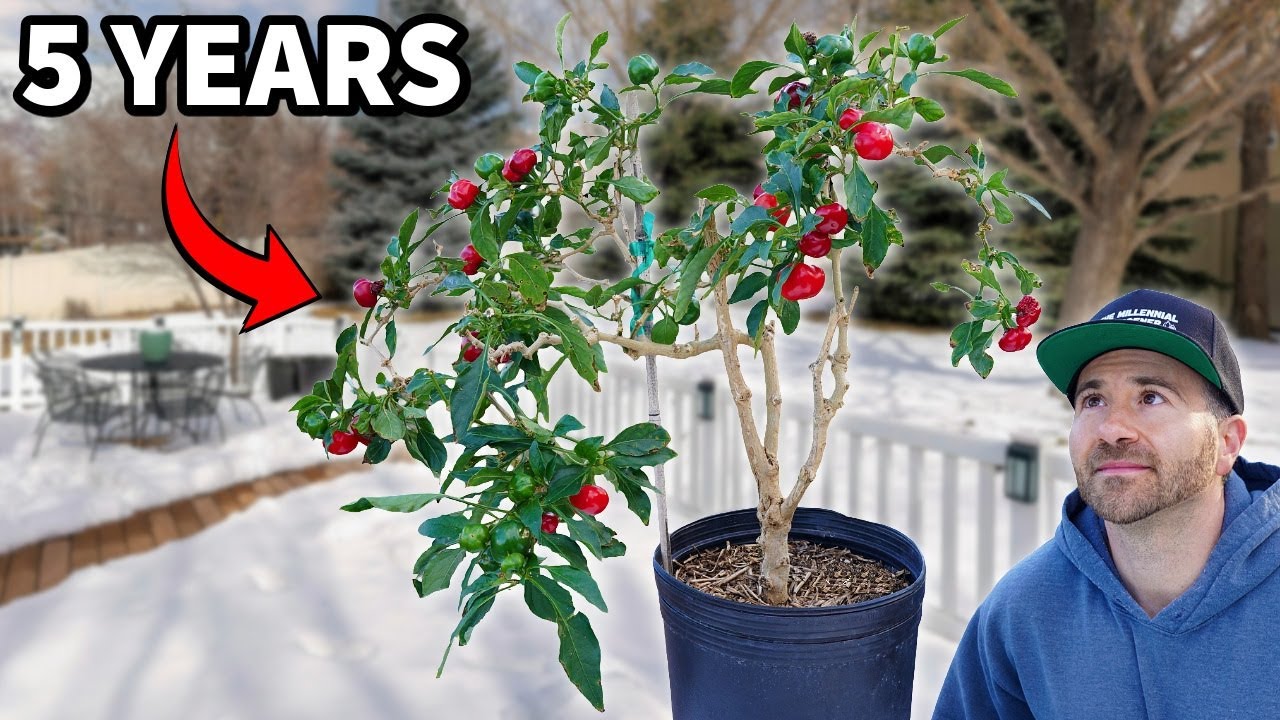Embark on my 5-year journey of overwintering pepper plants and discover the valuable lessons I’ve learned along the way. If you’re looking to extend your growing season and keep peppers thriving year-round, you’ll find practical insights and tips in this story that can help you succeed in your own gardening adventures.
My 5-Year Journey Overwintering Pepper Plants: What I Learned
Introduction
Imagine, if you will, a garden journey that’s less about planting seeds and more about coaxing stubborn green friends through a winter’s hibernation. That’s been my five-year dalliance with overwintering pepper plants—an eccentric hobby that turned into a stubborn obsession. It’s a tale sprinkled with triumphs, a few fiascos involving frostbite and misguided pruning, and a revelation that these fiery plants are far more resilient than I ever imagined. If you think peppers are purely annual delights destined for the summer salad, think again. These perennials—yes, perennials—have a secret life after the summer fades and the temperatures dip, and I am here to share their story, pepper by pepper.
This article isn’t just a nostalgic recount of failed attempts and sweet successes. It’s an ode to the art of overwintering peppers, a roadmap for those brave enough to try it, and a reminder that with a little care, patience, and the right tools, your chili champions can live on long after their outdoor days are done. So, whether you’re a seasoned gardener or a curious newbie, buckle up as I take you through the intricacies of digging, fertilizing, pruning, and protecting pepper plants for up to five glorious years.
The Surprising Perennial Nature of Pepper Plants
Let’s clear this up early—pepper plants are not your typical annuals, sprouting, flourishing, and then vanishing in one season like a Vegas act. No, they are perennials masquerading in annual clothing, waiting for the right conditions to outstay their welcome in your garden. It’s an act of defiance against nature’s usual rules; with proper overwintering, these spicy survivors can be your loyal garden companions year after year.
For the uninitiated, this revelation is a game changer. You might have looked at your pepper plants in September and thought, “Well, that’s that,” but in reality, they’re just taking a well-earned timeout. Overwintering is the secret handshake that keeps these luscious green orbs alive during the cold months, protected indoors or in a greenhouse, shielded from frost and despair. The process involves digging them up carefully, fertilizing with organic delights like fish fertilizer, and giving them a little pruning love. What’s astonishing is that, with consistent care, you could be harvesting peppers from the same plant for up to five years—an impressive feat of green resilience.
The best part? Choosing the right varieties matters. Cherry Hot, Jalapeño, Serrano, Banana peppers—all these can be coaxed into long-term friendships if nurtured properly. It’s like cultivating pepper loyalty; keep them happy, and they’ll reward you with spicy harvests again and again, seamlessly blending into your culinary pursuits and garden pride. Overwintering transforms a fleeting summer fling into a long-term relationship that surprisingly thrives thanks to a little bit of human intervention and a lot of love.
The Practical Magic of Overwintering
The process might sound straightforward, but it’s filled with subtle nuances that make or break your success. Watching the video tutorials I gathered over time, I learned that digging, fertilizing, and pruning are not chores but rituals—each one a step towards ensuring your pepper plants not only survive but thrive through the harshest months. Digging carefully around their root balls with pruning snips allows you to harvest any excess growth, keeping the plant’s energy focused on vital parts. Fertilization with gentle organic products like fish emulsion keeps nutrients flowing, acting as a health tonic that prevents the plant from waning under indoor dryness.
Protection is equally vital. I discovered that insect netting and shade cloth serve as invisibility cloaks against pests and intense sunlight, and kaolin clay added a whimsical, matte finish that deterred troublesome insects. A cozy spot indoors, preferably near a grow light tailored for peppers, creates a miniature summer paradise—just in a different season. The key is endurance, a lesson learned through years of trial, error, and researching community tips.
How to Overwinter Pepper Plants for Long-Term Success
When you set out to overwinter peppers, it’s like preparing a green refugee camp in your home or greenhouse. First, choosing the right containers—nursery pots or grow bags—makes all the difference in keeping roots happy. Moving plants indoors before the first frost is crucial; waiting too long risks frostbite that the plants won’t recover from, no matter how tough they appear. Once inside, the real work begins: pruning back leggy branches to encourage bushier growth, fertilizing with organic fish or botanical fertilizers to sustain energy, and maintaining a steady temperature that’s warm enough to beat the winter blues.
The art of overwintering isn’t just about survival; it’s about creating an environment for continuous growth. I found that regular maintenance—removing pests, adjusting the shade cloth, and ensuring light levels are sufficient—prevents the stress that can cause plants to wane. There’s also a rewarding element to repotting into larger containers if the roots outgrow their original digs; it’s like giving them a fresh start, a fresh pot, and a fresh chance to coast through winter. Over time, I learned to identify which varieties were most willing to brave the indoor life—Cherry Hot peppers on the balcony, Jalapeños snug in the laundry room—and I became a seasoned pepper refugee with a budding sense of pride.
The Long-Term Rewards
The payoff is not just in the immediate harvests, but in the long-term stability of your garden ecosystem. I’ve consistently harvested peppers from the same plants, year after year, with some stalwarts reaching five full seasons of spicy joy. The secret sauce? Consistent watering, appropriate fertilization, and strategic pruning to keep the plants compact and healthy. In my experience, these green warriors develop a resilience that’s truly inspiring, fighting off pests with subtle defenses like insect netting, while basking under grow lights that mimic summer’s sun.
Watching a pepper plant survive through multiple winters, particularly in colder climates, is a testament to plant resilience and human ingenuity. It’s a bit of a gamble, yes, but one worth taking—akin to keeping a wild pet that finally comes to trust and even adore you. Overwintering peppers isn’t just gardening; it’s an act of faith, patience, and a dash of green thumb magic.
Frequently Asked Questions
Can pepper plants really survive the winter indoors, and how do I make sure they thrive?
Absolutely, pepper plants can survive indoors with the right setup. When overwintering peppers inside, choose a warm, sheltered spot—near a grow light that mimics summer sunlight, ideally 12-16 hours a day. Keep the temperature consistent, around 65-75°F, and avoid drafts and cold windows. Regular fertilizing with organic options like fish fertilizer ensures they stay healthy, and pruning helps maintain shape and vigor. Monitoring pests, providing good air circulation, and making periodic adjustments are key to thriving during winter.
What are the best pepper varieties for overwintering, and why?
Varieties like Cherry Hot, Jalapeño, Serrano, and Banana peppers are superb choices for overwintering because of their hardy nature and prolific fruiting habits. They tend to be more forgiving if you miss a watering or forget to fertilize occasionally. These peppers also produce a good number of harvests over multiple seasons, making the extra effort worthwhile. Their adaptability to container life and indoor conditions makes them a gardener’s best friends when trying to extend the pepper season year-round.
How do I prune my pepper plants for overwintering without killing them?
Pruning is an art and a science. Trim away any dead or diseased branches, and cut back overly leggy growth to encourage bushier, more manageable plants. Use clean pruning snips, sterilized with rubbing alcohol after each cut, to prevent disease spread. The goal is to remove excess foliage that drains energy or exposes the plant to pests—think of it as giving your pepper plant a mini spa day. This encourages new, healthy growth when they are overwintered, and helps maintain a neat, compact shape suitable for indoor life.
What products can help optimize overwintering success?
The right tools and products can make all the difference. Use nursery pots or breathable grow bags for good root health, and incorporate grow lights designed for vegetable plants to ensure adequate light indoors. Fertilizers such as organic fish emulsion or compost tea keep nutrients flowing, while insect netting and shade cloth help ward off pests and harsh light. Kaolin clay sprays act as natural deterrents for insects, and supplemental heating in colder climates can prevent winter dormancy from turning into plant death. Amazon offers a variety of these essentials—your pepper’s new best friends.
How long can I realistically expect my overwintered peppers to keep producing?
With proper care, you can expect your overwintered pepper plants to produce for multiple seasons—often up to five years. While their productivity may decrease gradually, regular pruning, fertilization, and pest control help prolong their productive life cycle. With each passing year, the plants become more resilient, sometimes surprising you with vigorous new growth and a fresh crop of fruit well into the spring or early summer. It’s a slow, persistent process—like a green revolution in miniature that keeps giving back, season after season.
Final Thoughts
Overwintering pepper plants is less about strict gardening and more about embracing a quirky, persistent relationship with these fiery botanicals. It’s a testament to how patience, proper care, and a dash of ingenuity can turn a simple summer crop into a multipurpose, long-lasting green companion. My five-year journey has taught me that these plants are fighters, capable of not just surviving the cold but thriving in spite of it—if you’re willing to meet their needs with consistency, curiosity, and a bit of forethought.
Gardening, after all, is as much about stories—those stories of plants that defy expectations and flourish through the winter—as it is about pretty pots or perfect harvests. So, go ahead, give it a try. Dig deep, fertilize generously, prune wisely, and remember: sometimes the greatest rewards are hidden beneath frost and snow, waiting patiently to burst forth again.
Engage with fellow pepper aficionados—share your tips, ask questions, or just brag about your monster peppers in the comments. After all, the garden community thrives when we swap stories and secrets.

